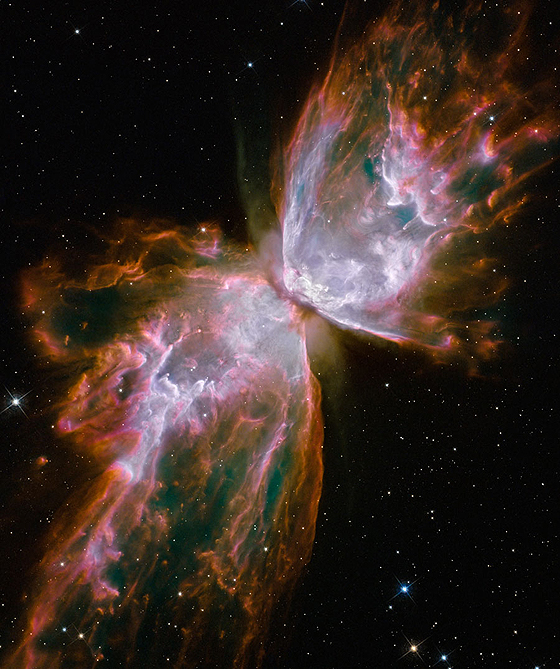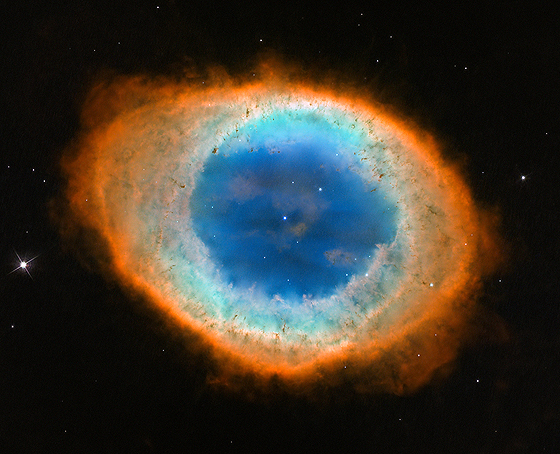Here are some beautiful space photos and videos that have been posted on the Internet recently. Enjoy!

Image Credit: NASA, ESA, and the Hubble SM4 ERO Team
The bright clusters and nebulae of planet Earth’s night sky are often named for flowers or insects. Though its wingspan covers over 3 light-years, NGC 6302 is no exception. With an estimated surface temperature of about 250,000 degrees C, the dying central star of this particular planetary nebula has become exceptionally hot, shining brightly in ultraviolet light but hidden from direct view by a dense torus of dust. This sharp and colorful close-up of the dying star’s nebula was recorded in 2009 by the Hubble Space Telescope’s Wide Field Camera 3, installed during the final shuttle servicing mission. Cutting across a bright cavity of ionized gas, the dust torus surrounding the central star is near the center of this view, almost edge-on to the line-of-sight. Molecular hydrogen has been detected in the hot star’s dusty cosmic shroud. NGC 6302 lies about 4,000 light-years away in the arachnologically correct constellation of the Scorpion (Scorpius).
This July Fourth the solar system is showing off some fireworks of its own.
Superficially resembling a skyrocket, comet ISON is hurtling toward the sun presently at a whopping 48,000 mph (77,00 kph).
Its swift motion is captured in this time-lapse movie made from a sequence of pictures taken May 8, 2013, by NASA’s Hubble Space Telescope. At the time the images were taken, the comet was 403 million miles (649 million kilometers) from Earth, between the orbits of Mars and Jupiter.
The movie shows a sequence of Hubble observations taken over a 43-minute span and compresses this into just five seconds. The comet travels 34,000 miles (55,000 kilometers) in this brief video, or 7 percent of the distance between Earth and the moon. The deep-space visitor streaks silently against the background stars.
Unlike a firework, the comet is not combusting, but in fact is pretty cold. Its skyrocket-looking tail is really a streamer of gas and dust bleeding off the icy nucleus, which is surrounded by a bright star-like-looking coma. The pressure of the solar wind sweeps the material into a tail, like a breeze blowing a windsock.
As the comet warms as it moves closer to the sun, its rate of sublimation (a process similar to evaporation in which solid matter transitions directly into gas) will increase. The comet will get brighter and its tail will grow longer. The comet is predicted to reach naked-eye visibility in November.
The comet is named after the organization that discovered it, the Russia-based International Scientific Optical Network.
The Hubble Space Telescope is a project of international cooperation between NASA and the European Space Agency. NASA’s Goddard Space Flight Center in Greenbelt, Md., manages the telescope. The Space Telescope Science Institute in Baltimore, Md., conducts Hubble science operations. STScI is operated by the Association of Universities for Research in Astronomy Inc., in Washington, D.C.

Image Credit: NASA, ESA, and the Hubble Heritage (STScI / AURA)- ESA /Hubble Collaboration
Except for the rings of Saturn, the Ring Nebula (M57) is probably the most famous celestial band. Its classic appearance is understood to be due to our own perspective, though. The recent mapping of the expanding nebula’s 3-D structure, based in part on this clear Hubble image, indicates that the nebula is a relatively dense, donut-like ring wrapped around the middle of a football-shaped cloud of glowing gas. The view from planet Earth looks down the long axis of the football, face-on to the ring. Of course, in this well-studied example of a planetary nebula, the glowing material does not come from planets. Instead, the gaseous shroud represents outer layers expelled from the dying, once sun-like star, now a tiny pinprick of light seen at the nebula’s center. Intense ultraviolet light from the hot central star ionizes atoms in the gas. In the picture, the blue color in the center is ionized helium, the cyan color of the inner ring is the glow of hydrogen and oxygen, and the reddish color of the outer ring is from nitrogen and sulfur. The Ring Nebula is about one light-year across and 2,000 light-years away.
“Existence A Time Lapse Project” Some beautiful imagery of the Milky Way as well as scenes from urban and remote locations.